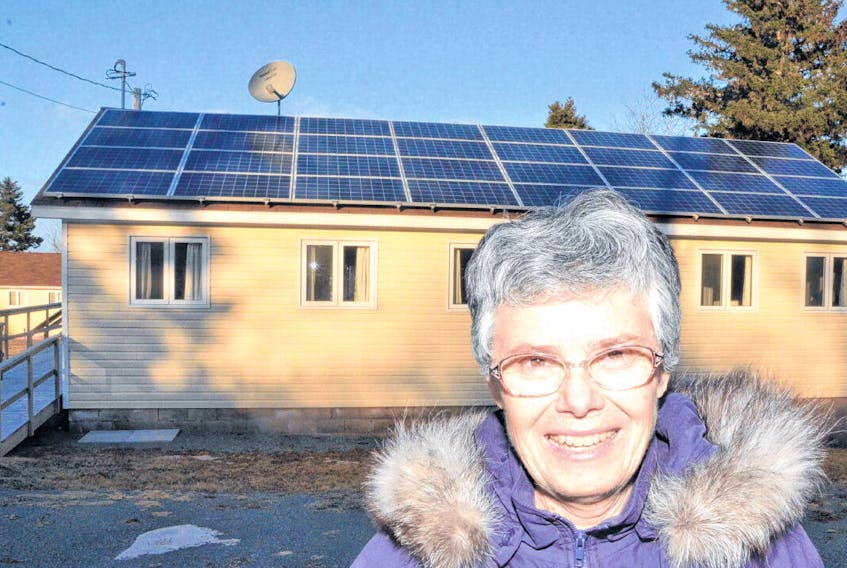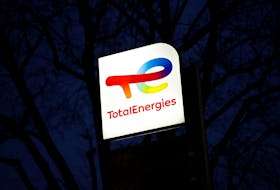In 2008, the Sisters of St. Martha were looking to continue a long tradition of acting on their beliefs.
“We really have a sense of the oneness of everything and being called to be in right relationship with creation,” said Sister Donna Brady on Tuesday.
The Antigonish-based order wanted to reduce their carbon footprint.
But beyond their desire to tread softly on this warming planet, they also had to be financially prudent.
“At the time (2008), solar panels were just too expensive,” said Brady.
According to the National Energy Board the installed price of solar panel-generated electricity in 2004 was $6.18 per watt. By 2014 improvements to the technology in photovoltaic cells and the efficiencies created by larger production brought the price down to 85 cents per watt.
The price to install solar panels has continued to drop while electricity, bought off the grid, has been heading in the other direction.
On Jan. 31, Nova Scotia Power filed its annual net metering report to the province’s utility and review board.
While still small, the report shows that the number of Nova Scotians tying solar power-generated electricity into the grid from their homes is increasing exponentially.
In 2015, 43 homes and businesses in this province began producing electricity using solar panels. In 2016, it was 89 homes and businesses, and in 2017 the number went up to 133. Nova Scotia Power predicts that 150-160 new solar systems will be added to the grid in 2018.
“This upward trend may be attributable to reduced costs, increased financing options and increased marketing by the solar industry, which has in turn increased customer interest,” reads the report.
Net metering basically allows a home or business that has installed solar panels to use theprovincial grid as a battery. Because when it’s sunny the panels often produce more electricity than a building needs, the extra electricity is fed back onto the grid and the power is purchased from the homeowner by Nova Scotia Power at the same rate that the utility sells it.
The downside for Nova Scotia Power is that it must maintain the capacity to produce electricity even when it’s not sunny. NSP is a wholly owned subsidiary of Halifax- based energy conglomerate Emera Inc. and it has been mandated by the province to provide the service.
“The increase in net metering connections reveals a trend that should be monitored to understand the impact of a cost imbalance between net meter customers and other customers on the system,” cautions the report.
Only about 1.3 megawatts were produced by the 453 personal net-metered systems around the province in 2017, compared to 10,000 gigawatts produced by Nova Scotia Power’s many generating plants. But that’s going to change.“Solar is getting more affordable every year and the cost of buying electricity from the grid is going up,” said Brian Rose, coowner of Appleseed Energy.
The Isle Madame company installed nearly 30 net-metered solar systems around the province last year.
A system that will offset the annual electrical consumption of a home that doesn’t use electric heat will cost almost $15,000. To replace the electrical demand of an efficient home with baseboards or a heat pump will typically cost $20,000 to $30,000.
“On a new house, if you put that extra cost into the mortgage the amount added to your payments will be much lower than what your electricity costs would be,” said Rose.
For a retrofitted home, he explained, the owner would pay for the system for nine to 11 years at a rate comparable to what they would have paid to purchase the electricity from NSP.
“But after that your electricity is free and the systems have a 25-year warranty,” said Rose.
A group called the Antigonish Community Energy Cooperative, which covers an area from Colchester County and into Cape Breton, is into its third “group buy,” which allows its members to save 10 to 15 per cent on the upfront cost of panels through buying in bulk. A free home assessment also comes with the $5 membership.
The co-operative group will be hosting information sessions on Feb. 20 at 7 p.m. at the St. Andrews Community Centre and on March 8 at 7 p.m. at the Cranton Cross Roads Community Centre in Margaree.
On Tuesday, Sister Brady was looking at the solar panels that the Sisters of St. Martha had teamed up with the Antigonish Community Energy Cooperative to install on two of their cottages — one of 50 solar installs the group has done over the past three years.
“We heat the cottages year round and this puts a dent in our costs,” said Brady.
And more importantly to the order of nuns, it brings them into a more “right relationship” with the natural world.









